Earlier this year, the CPM ran an art competition, asking students in Years 7 to 9 in UK schools to send in art around a theme of ‘measurements in health and disease’ (follow this link to see a video introducing the competition). We were so delighted and impressed with the quality of the entries we received. This blog post talks through the winners and finalists – we hope you enjoy these thought-provoking pictures as much as we did.
Winner
Our winning entry is this stunning artwork created by Aneesa, aged 12, from Oxford High School in Oxfordshire:
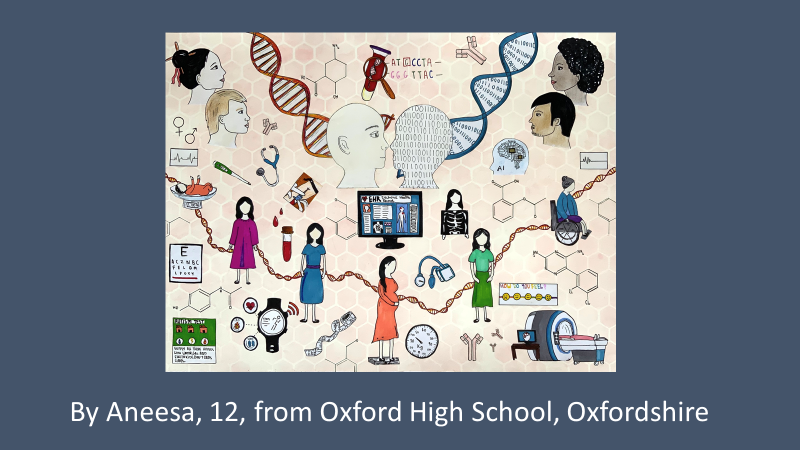
Aneesa wrote ‘My artwork, “A Lifetime of Measures” represents everything I learnt about personalised medicine and the fascinating ways changes in health are monitored and conditions identified. I realised traditional measures such as scales or thermometers are not obsolete but complementary to modern measures to develop and provide the right treatment for each person. The “digital twin” is a focus as it is a way to capture all the measurements and use these to assess health risks over time. My art shows how important DNA analysis is and how age, sex and ethnicity though simple are important when deciding the best treatment. It shows measures are important at different stages of life and may mean different things at different stages. I noticed that many chemicals used as medicines have hexagonal rings, so I decided to choose a hexagon pattern for my background to represent known and future personalised medicines.‘
The judges were so impressed with Aneesa’s entry and how it conveyed the use of measurements throughout a lifetime, and the idea of the digital twin. We really enjoyed how it invites the viewer to reflect on so many different aspects of measurements in health and disease.
Runner-up
Our runner-up is this beautiful entry from the KS3 Art Club at Bartholomew School in West Oxfordshire:

The Art Club explained that ‘The unique identity of every student who has been involved in this piece of art is represented by a single petri dish. The characteristic we have chosen to represent the measurement of health and disease is our genome. Our petri dish cell art contains many facets of our individuality, from our fingerprints to our genetic code. Each strand of our DNA contains mutations which are unique, communicating our individuality with precision. This information will allow physicians to predict and prevent future disease, personalising and targeting intervention.‘
The judges thought this entry was really attractive and thought-provoking, and we loved the way that the students had clearly worked together to create something very striking that beautifully illustrates the uniqueness of each person’s medical measurements but also the benefits of looking at these measurements across groups of people.
Highly Commended
We were really lucky to have so many great entries from incredibly talented students – all the following artworks were highly commended by the judges.

Maanashi, aged 13, from Durham High School in County Durham, sent in this particularly moving entry. Maanashi explained that ‘My artwork shows a patient at the hospital during the COVID-19 pandemic, where a hospital monitor is measuring their heart rate/ temperature/ blood pressure etc. This hospital monitor and its machines are what doctors and nurses are depending on, for the right readings and to save a life that is on the line. But my artwork also shows the people at home who are anticipating every next minute, those who are hoping to be reunited with their loved ones again.‘ The judges loved how Maanashi illustrated the role of medical measurements in guiding care for a person who is really ill, but also how the importance of the person goes so far beyond just measurements.
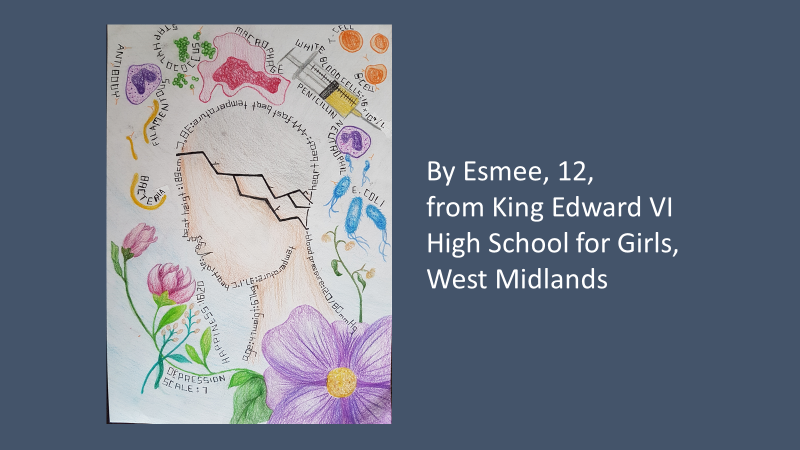
Esmee, aged 12, from King Edward VI High School for Girls in the West Midlands, drew this beautiful picture. She wrote that ‘My artwork shows a person who feels well and enjoying life who gets sepsis. The measurements show the changes in measurements that happen between being well and having a bacterial infection.‘ The judges were really impressed by how Esmee’s entry contrasted measurements in health and disease.
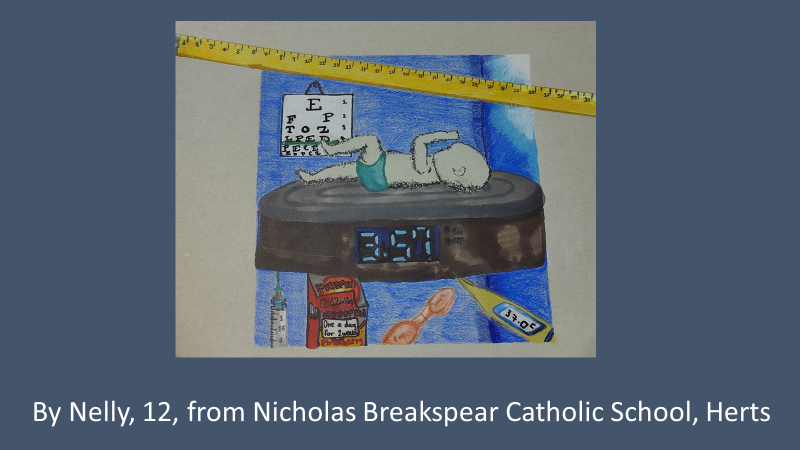
Nelly, aged 12, from Nicholas Breakspear Catholic School in Hertfordshire, contributed this striking illustration. Nelly wrote ‘My artwork shows a variety of different measurements used as health care procedures for a baby. For my drawing I used coloured pencils and pens. I have incorporated realism and a bit of scribbling too. My drawing also displays shadows, highlights and mid-tones.‘ The judges really liked how Nelly’s picture shows that medical measurements are part of our life long before we become aware of them and start to understand them.
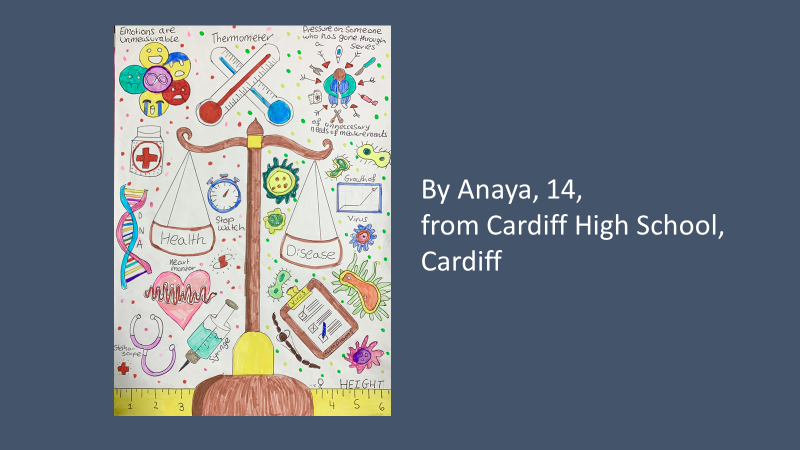
Anaya, aged 14, from Cardiff High School, sent in this very informative entry. The judges were struck by the way this piece showed various measuring devices all contributing to an overall balance between health and disease, and also how Anaya highlighted various challenging aspects relating to measurements, for example showing a person overwhelmed by undergoing lots of unnecessary measurements, and raising the difficulty of measuring emotions.
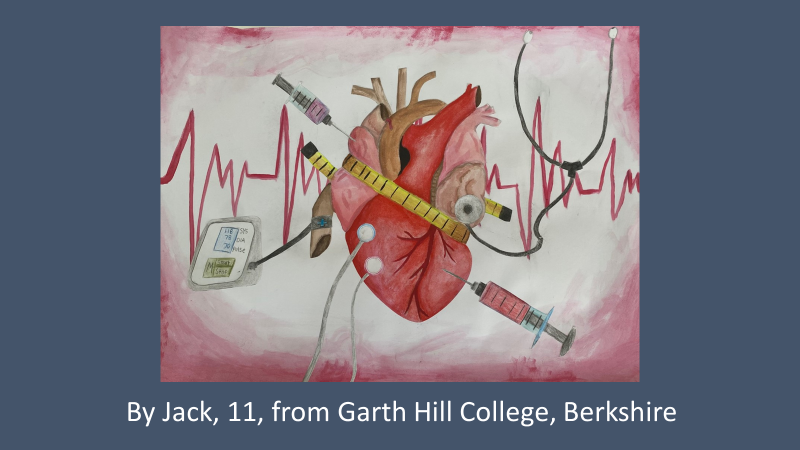
Jack, aged 11, from Garth Hill College in Berkshire, sent in this powerful entry. Jack explained ‘This piece of art is about the importance of keeping your heart healthy and how some people refuse to have certain measurements taken and how that can affect their health. It could also prevent doctors from seeing important details which could help catch illness and diseases before they get more serious.‘ Jack’s image really grabbed the judges’ attention and we loved how it showcased the importance of medical measurements.

Trisha, aged 12, from Tiffin Girls School, created this very evocative artwork. The judges really liked how it showed a girl experiencing a medical measurement but also made us think about what it was like for her feeling ill.
Congratulations to our winners and finalists, and thank you to everyone who entered or supported this year’s Centre for Personalised Medicine schools art competition. We so enjoyed looking at these wonderful entries and they really made us think about measurements in health and disease in new and interesting ways.
We are making plans for exhibiting the best competition entries in Oxford over the course of the year – please follow us on Twitter for updates regarding this. We hope to run the competition again in future years.